
Dr. Alejandro Manjavacas received his M.S. and Ph.D degrees from Universidad Complutense de Madrid in 2009 and 2013, respectively, working under the supervision of Prof. García de Abajo. After completion of his Ph.D., he moved to Rice University in 2013 as the J. Evans Attwell Welch postdoctoral fellow working in the group of Prof. Peter Nordlander. In the summer of 2015, Alejandro obtained a tenure-track position as Assistant Professor at the University of New Mexico (USA), and was later promoted to Associate Professor with tenure. Since 2020, he is a Tenured Scientist at the Institute of Optics of the Spanish National Research Council. Dr. Manjavacas is the recipient of several awards including the RSEF-BBVA Foundation award to the best young theoretical physicist in Spain, the NSF Career Award from the US, and the Leonardo Grant. The focus of his research is to understand the fundamentals of the light-matter interaction at the nanoscale. He has co-authored 80 articles and reached over 6000 citations with a h-index of 36 (Google Scholar).
Title: Lattice resonances: a collective response of periodic arrays of nanostructures
Abstract: Periodic arrays of metallic nanostructures are able to support collective modes known as lattice resonances. These excitations occur at wavelengths commensurate with the periodicity of the array and give rise to very strong and spectrally narrow optical responses. Thanks to these exceptional properties, periodic arrays are being exploited in a wide variety of applications, including ultrasensitive biosensing, nanoscale light emission, and color printing, to cite a few. In this talk, we will discuss some recent theoretical advances on the topic of lattice resonances. We will pay particular attention to the near- and far-field properties of these modes and how they depend on both the characteristics of the array and the source used to excite them.
